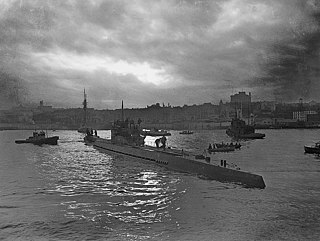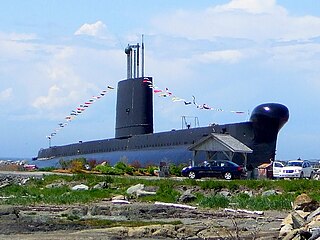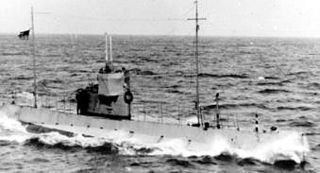
The Upholder/Victoria-class submarines, also known as the Type 2400, are the class of the diesel-electric submarines built in the United Kingdom in the 1980s to supplement the nuclear submarines in the Submarine Service of the British Royal Navy.

German submarine U-190 was a Type IXC/40 U-boat of Nazi Germany's Kriegsmarine built for service during World War II.

HMCS Victoria is a long-range hunter-killer (SSK) submarine of the Royal Canadian Navy, the lead ship of her class. She is named after the city of Victoria, British Columbia. She was purchased from the Royal Navy, and is the former HMS Unseen (S41). The class was also renamed from the Upholder class.

HMCS Toronto is a Halifax-class frigate that has served in the Canadian Forces since 1993. Toronto is the fourth ship in her class which is the name for the Canadian Patrol Frigate Project. She is the second RCN ship to be named for Canada's largest city. When not on operations she is assigned to Maritime Forces Atlantic (MARLANT) and is based at CFB Halifax. Toronto serves on MARLANT missions protecting Canada's sovereignty in the Atlantic Ocean and enforcing Canadian laws in its territorial sea and exclusive economic zone.

HMCS Onondaga (S73) is an Oberon-class submarine that served in the Royal Canadian Navy and later the Canadian Forces. Built in the mid-1960s, Onondaga operated primarily with the Maritime Forces Atlantic until her decommissioning in 2000 as the last Canadian Oberon.

HMCS Okanagan (S74) was an Oberon-class submarine that served in the Canadian Forces (CF). She entered service in 1968 and spent the majority of her career on the east coast. The ship was paid off in 1998 and sold for scrap in 2011.

HMCS Ojibwa is an Oberon-class submarine that served in the Royal Canadian Navy (RCN) and later the Canadian Forces Maritime Command (MARCOM). Originally intended for service with the British Royal Navy as HMS Onyx, the submarine was transferred to Canadian ownership before completion, and entered RCN service in 1965. Ojibwa operated primarily with Maritime Forces Atlantic until her decommissioning in 1998. In 2010, Ojibwa was laid up at CFB Halifax awaiting disposal, with the Elgin Military Museum planning to preserve her as a museum vessel. The submarine was towed to Port Burwell, Ontario in 2012, and was opened to the public in 2013. She is now the new focal point of a planned Museum of Naval History to be built alongside.

HMCS Chicoutimi is a Victoria-class long-range hunter-killer (SSK) submarine of the Royal Canadian Navy, originally built and operated by the Royal Navy as HMS Upholder. Shortly after being handed over by the United Kingdom to Canada she was involved in a partial flooding incident which resulted in a fire at sea. The incident sparked a fierce debate over the value of the purchase of this group of second-hand vessels, as well as the handover inspection process. The subsequent investigation "determined the fire was caused by human, technical and operational factors, [and] the board cleared the commanding officer and crew of any blame." The submarine was repaired and entered Canadian service in 2015.

HMCS Yukon was a Mackenzie-class destroyer that served in the Royal Canadian Navy (RCN) and later the Canadian Forces. She was the first Canadian naval unit to carry the name. She was named for the Yukon River that runs from British Columbia through Yukon and into Alaska in the United States.

HMCS Calgary is a Halifax-class frigate that has served in the Canadian Forces and Royal Canadian Navy since 1995. Calgary is the sixth vessel in her class and the second vessel to carry the designation HMCS Calgary. She was built as part of the Canadian Patrol Frigate Project. Calgary began the FELEX refit in June 2012. She is assigned to Maritime Forces Pacific (MARPAC) and is homeported at CFB Esquimalt. Calgary serves on MARPAC missions protecting Canada's sovereignty in the Pacific Ocean and enforcing Canadian laws in its territorial sea and exclusive economic zone.

HMCS Montréal is a Halifax-class frigate that has served in the Canadian Forces since 1993. Montréal is the seventh ship in her class which is based on the Canadian Patrol Frigate Project. She is the second vessel to carry the designation HMCS Montreal. She is assigned to Maritime Forces Atlantic (MARLANT) and is homeported at CFB Halifax. Montréal serves on MARLANT missions protecting Canada's sovereignty in the Atlantic and Arctic Oceans and enforcing Canadian laws in its territorial sea and Exclusive Economic Zone. The ship has also been deployed on missions throughout the Atlantic and to the Indian Ocean; specifically the Persian Gulf and Arabian Sea on anti-terrorism operations. The vessel has also participated in several NATO missions, patrolling the Atlantic Ocean as part of Standing Naval Force Atlantic (STANAVFORLANT) and its successor Standing NATO Response Force Maritime Group 1 (SNMG1). The vessel is designated as a Bilingual Language Unit in the Royal Canadian Navy.

HMCS St. John's is a Halifax-class frigate that has served in the Canadian Forces and the Royal Canadian Navy since her commissioning in 1996. She is the eleventh of twelve ships in her class which is based on the Canadian Patrol Frigate Project. St. John's is named after the city of St. John's, Newfoundland and Labrador, a port city associated with Canadian naval history and heritage, and is the first ship in the Royal Canadian Navy to bear the name.

HMCS Algonquin was an Iroquois-class destroyer that served in the Royal Canadian Navy (RCN) from 1973 to 2015.

HMCS CC-1 was a CC-class submarine used by the Royal Canadian Navy. Acquired by British Columbia at the outbreak of the First World War, the ship had been initially built for Chile as Iquique. However, after a dispute with the shipyard, Chile refused the submarine and the shipyard owners sold the vessel to Canada instead. Renamed CC-1 in Canadian service, the vessel was commissioned in 1914 and remained active through the war. Following the war, the submarine was laid up and was discarded in 1920.

HMCS Mackenzie was a Mackenzie-class destroyer that served in the Royal Canadian Navy (RCN) and later the Canadian Forces. She was the lead ship of her class and is the first Canadian naval unit to carry this name. The ship was named for the Mackenzie River, the largest river system in Canada and runs primarily through the Northwest Territories.

HMCS Qu'Appelle was a Mackenzie-class destroyer that served in the Royal Canadian Navy and later the Canadian Forces. The ship's insignia and logo was the head of a fox facing forward centered in a diagonal line double white with a red center sqiggley line from the top left to bottom right. The moniker of the ship was "Follow the Fox".

HMCS Saskatchewan was a Mackenzie-class destroyer that served in the Royal Canadian Navy (RCN) and later the Canadian Forces. She was the second Canadian naval unit to bear the name HMCS Saskatchewan. The ship was named for the Saskatchewan River which runs from Saskatchewan to Manitoba in Canada.

HMCS Windsor is a long-range hunter-killer (SSK) submarine of the Royal Canadian Navy, the second submarine of the Victoria class. She is named after the city of Windsor, Ontario. Built for the Royal Navy as the Upholder-class submarine HMS Unicorn she was purchased by Canada when the United Kingdom decided to move to an all-nuclear power fleet.

HMCS Waskesiu was a River-class frigate of the Royal Canadian Navy. The frigate served as a convoy escort in the Battle of the Atlantic during the Second World War. It was the first frigate constructed and commissioned into the Royal Canadian Navy. Following the war, the vessel was sold to India where it was renamed Hooghly. Named after the town of Prince Albert, Saskatchewan, there was already a warship named "Prince Albert". The Royal Canadian Navy then named the ship after the town closest to Prince Albert National Park.

HMCS Harry DeWolf is the lead ship of its class of offshore patrol vessels for the Royal Canadian Navy (RCN). The class was derived from the Arctic Offshore Patrol Ship project as part of the National Shipbuilding Procurement Strategy and is primarily designed for the patrol and support of Canada's Arctic regions. Named after Vice Admiral Harry DeWolf, a former head of the RCN, the vessel was ordered in 2011, laid down in 2016 and launched in 2018. The vessel completed contractors sea trials in July 2020, was delivered to the RCN on 31 July 2020 and began post-acceptance sea trials. Harry DeWolf was commissioned on 26 June 2021.




















